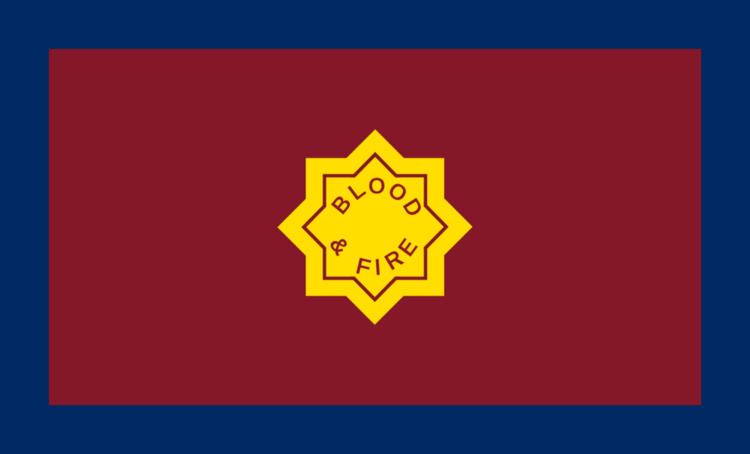 | ||
The Salvation Army in Australia (nicknamed "Salvos" in Australian English) is an evangelical Christian church known for its charity work. It began operating in Australia since the late 19th Century. Administratively it is now divided between The Salvation Army, Australia Eastern Territory and The Salvation Army, Australia Southern Territory.
Contents
History
The first Salvation Army meeting in Australia was held in 1880. Edward Saunders and John Gore led the meeting from the back of a greengrocer's cart in Adelaide Botanic Park with an offer of food for those who had not eaten. In 1883, Major James Barker led the way to establish the first Salvation Army social institution anywhere in the world on a permanent basis, known as the "Prison Gate" program. Barker saw that prisoners being released from the Melbourne Gaol had nowhere to go and no work, so they inevitably re-offended and returned to gaol. Barker leased a small house in Lygon Street, Carlton, to provide accommodation for prisoners discharged from Melbourne's gaols. This led to the formation of the Prison-Gate Brigade, the members of which met discharged prisoners upon their release and offered them a home and the prospect of a job. The Salvos also involved themselves in finding work for the unemployed and in re-uniting families. In Melbourne from 1897 to 1910, The Army's Limelight Department was established as Australia's first film production company.
Eighty-four cents in every dollar donated to The Salvation Army goes directly to those in need. This is one of the most efficient rates of any charity in Australia. It is thought that the name of the popular biscuit by Arnotts, SAO, stands for ‘Salvation Army Officer’.
The Salvation Army helps more than one million Australians every year. In an average week, the Salvation Army provides an estimated:
From these diverse activities, The Salvos have grown to be one of Australia's most respected charitable organisations, with a 2009 survey by Sweeney Research and the advertising group Grey Global finding the Salvation Army and the nation's Ambulance Service to be Australia's most trusted entities.
Australia's George Carpenter was General of the Salvation Army (worldwide leader) from 1939–1946 and Eva Burrows during the 1980s and 1990s.
Salvation Army Growth 19th Century
The Salvation Army grew quickly within Australia, but it was a growth fraught with difficulty. In its early days The Salvation Army often met with suspicion, derision and violence. Salvationists simply walking down the streets would often suffer abuse and sustain injury from thrown objects. Several local councils even passed by-laws forbidding Salvation Army street processions, and the Police were liable to arrest them. From 1881 to 1907, across the country, more than 100 Salvationists were fined or jailed for holding street-meetings and marches.
"Almost every night some of our soldiers are getting hurt. One night during the week, as we were all having our usual open-air meeting, a crowd of 200 roughs gathered around, and threw lumps of road metal. One piece struck the Captain on the mouth and split one of his teeth, and loosened two others; yet, with all, we were able to sing, 'Hallelujah!' "Another night a sister got struck on the head, almost forcing her to the ground. In the face of all, there are certain officials of the law who stand by and enjoy the brutal sport."
Despite persecution and prosecution the number of Salvation Army Corps grew at an amazing rate, so much so that by 1900 there were over 1,300 Corps and outposts across Australia and New Zealand and The Salvation Army in Australasia could boast the following statistics:
Australian sex abuse cases
From the 1940s to the 1980s the Salvation Army in Australia sheltered approximately 30,000 children. In 2006 the Australian Salvation Army acknowledged that sexual abuse may have occurred during this time and issued an apology. In it, the Army explicitly rejected a claim, made by a party unnamed in the apology, that there were as many as 500 potential claimants.
In 2013 it was reported that private settlements totalling A$15.5 million had been made in Victoria relating to 474 abuse cases; a Salvation Army spokesman said that "This should not have happened and this was a breach of the trust placed in us" and that they were "deeply sorry" whilst claiming that the abuse was "the result of individuals and not a culture within the organisation."
On 28 January 2014, the Royal Commission into Institutional Responses to Child Sexual Abuse, a royal commission of inquiry initiated in 2013 by the Australian Government and supported by all of its state governments, began an investigation into abuse cases at the Alkira Salvation Army Home for Boys at Indooroopilly; the Riverview Training Farm (also known as Endeavour Training Farm) at Riverview – both in Queensland; the Bexley Boys’ Home at Bexley; and the Gill Memorial Home at Goulburn – both in New South Wales. The investigation also examined The Salvation Army's processes in investigating, disciplining, removing and/or transferring anyone accused of, or found to have engaged in, child sexual abuse in these homes. On 27 March 2014, the Royal Commission began an investigation into the handling by The Salvation Army (Eastern Territory) of claims of child sexual abuse between 1993 and 2014.
Many questions were raised during the course of the investigation as to whether high-ranking members of the organisation knew about these cases of child sexual abuse and failed to investigate, discipline, sack and prosecute sex offenders while boys and girls were beaten, bashed and raped.
The Royal Commission published a case study report on the findings and recommendations for one of the abovementioned case studies.
